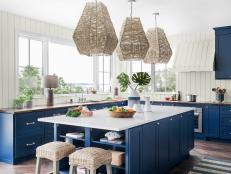Kitchen Flooring Options
Your kitchen floor needs to stand up to a lot of foot traffic and potential spills, so consider durability and ease of maintenance when choosing materials. But that shouldn't mean you should ignore style — floors play a key part in tying the look of the room together.
Porcelain tile rules the floor space because of its durability, versatility, availability in a range of colors, textures and designs, and affordability compared to natural stones. These tiles are fired at about 1800 degrees Fahrenheit, so they're tough as nails and aren't likely to chip, crack or discolor. Limestone, slate, travertine and other natural surfaces lend character to a space, but they do tend to scratch easier than porcelain tile, and they are more absorbent so more likely to stain.
Floor tiles are larger today than ever before. A standard 12-inch tile evolved into 16-inch squares, which grew into 18-inch tiles and today, you'll find 21- and 24-inch tiles in kitchens of all sizes. (Small kitchens can also handle big tiles — fewer grout lines create a sleek space.)
Bigger tiles are better today, too, because of technology that allows manufacturers to develop tiles without warping issues that used to be a problem.
Hardwood floors are timeless and soft on the foot, making them nice for chefs that spend a lot of time on their feet in this space. Also, hardwood floors might flow into hardwood in adjacent rooms, creating a seamless line. This effect truly connects the kitchen to other living spaces in the home.




































